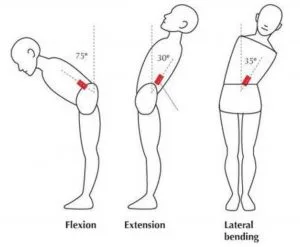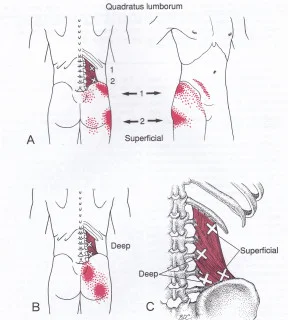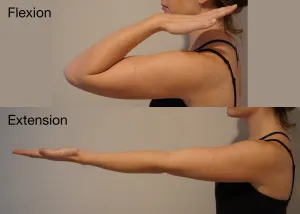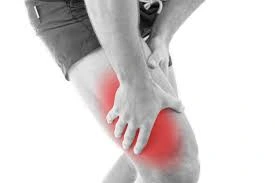Lumbar Extension
What is a Lumbar Extension?
Lumbar extension is the bending backward of the spine, focusing on the lower back (lumbar) area. It often involves exercises that arch the back in a controlled manner to strengthen muscles, increase flexibility, and support the spine.
It helps strengthen the lower back muscles, improve posture, and relieve pressure on spinal discs.
What is Lumbar Flexion And Extension?
The two primary movements at the lumbar area are flexion and extension.
Lumbar Flexion: This action lowers the angle between the front of the pelvis and the rib cage by bending the lower back forward.
Lumbar Extension: The motion opposite to flexion is called lumbar extension. Arching the lower back backwards increases the angle between the rib cage and the front of the pelvis. Imagine how you move when you stand with your back angled forward a little. Lumbar extension makes it easier to do things like glance up or get out of a chair.
For the spine to be healthy overall, lumbar flexion and extension are both necessary. A suitable and healthy lower back is supported by stability, proper alignment, and maintaining balance between these actions. To prevent strain or spine damage, these exercises must be performed correctly. It is advisable to speak with a healthcare professional if you are experiencing discomfort or are concerned about the state of your spine.
What is Lumbar Extension?
The lumbar region, the lowest section of the spine, can bend backwards in a movement known as a “lumbar extension.” As a result of this movement, the lower back arches in opposition to the normal curve of the spine To improve flexibility and strengthen the muscles in the lower back, lumbar extension exercises are commonly utilized in physical therapy and fitness programs. These exercises must be done correctly, though, to prevent back strain or damage. Always get medical advice before starting a new workout program, particularly if you currently have back issues.
Lumbar Extensor Muscles
The lower back’s lumbar extensor muscles work together to lengthen and straighten the spine. These muscles are crucial for maintaining proper posture in addition to keeping the spine stable and allowing a range of movements, such as standing up from a chair or arching the back. These are the primary lumbar muscles:
- Erector spinae: The muscles that run down the sides of the spine are known as the paraspinal muscles, and they are responsible for stretching the back.
- Multifidus: These tiny muscles, which span the length of the spine, give each vertebral segment stability and support. They contribute to preserving appropriate spinal alignment and managing spinal motions.
- Quadratus lumborum: This muscle, which is situated on either side of the lumbar spine, aids in the extension and lateral flexion (side bending) of the spine in addition to stabilizing the lower back.
- Iliopsoas: Although hip flexion is the iliopsoas’ principal role, when the hip is stable, it also aids in lumbar extension.
Lower back pain can be relieved, injury risk can be decreased, and back stability can be enhanced by strengthening these muscles with specific exercises. Before beginning any exercise program, it’s crucial to speak with a trained healthcare provider or fitness specialist, particularly if you already have back problems.
Lumbar Extension Range of Motion
The range of motion for lumbar extension is the amount of backward bending that the lower part of the spine, particularly the lumbar region, can achieve. This motion, which is expressed in degrees, indicates the extent to which the lumbar spine may arch in the opposite direction of its normal curvature.
Depending on a person’s age, level of flexibility, spinal health, and any underlying medical issues, their lumbar extension range of motion varies. For lumbar spine extension, the typical range is 20 to 35 degrees. This range, however, can be shortened or expanded based on specific considerations.
It’s critical to keep in mind that excessive lumbar extension, especially when performed incorrectly or under stress, may increase the risk of harm to the spinal structure. It is advised that lumbar extension exercises be carried out under the supervision of a trained fitness expert or healthcare professional to guarantee both safety and efficacy.
Methods for Determining Lumbar Extension Range of Motion
Examining the lumbar extension range of motion with the guidance of a certified physical therapist or other medical professional is advised. Here is a broad overview of how it can be evaluated, though:
- Preparation: Wear loose-fitting clothing to allow for mobility. To complete the test, find a peaceful, safe place.
- Warm-Up: Mild aerobic activity, dynamic stretches, or mobility exercises can all help to increase blood flow and relax muscles.
Methods of Assessment:
- Hands-on Measurement: Using their hands, a medical professional can direct and gauge the range of motion. As they check for any restrictions and monitor your mobility by placing their hands on certain parts of your spine, they will encourage you to perform controlled lumbar extension.
- Visual Assessment: To determine how much your spine arches and curves, you might perform lumbar extension exercises while facing a mirror. Any asymmetry or abnormalities in the movement can be identified by a medical professional using this method.
- Goniometer: In certain situations, a goniometer can be used to measure joint angles. The doctor will set the goniometer along your spine and evaluate the degree of extension as you move.
- To test your lumbar extension range of motion, patients typically bend the lower back while maintaining an upright posture. Standing or lying on your stomach may need you to arch your lower back as far as is comfortable.
- Note and Interpretation: The doctor will take note of the measurement and assess when the patient’s movement is restricted, uncomfortable, or painful. We’ll compare your range of motion to what’s normal for your age and physical state.
Keep in mind that lumbar extension range of motion determination requires skill to ensure accurate assessment and prevent any kind of injury. Always see a physician or physical therapist before starting any range-of-motion exercises or testing related to the spine.
Lumbar Extension Test
The Modified Schober Test is a frequently used method to evaluate lumbar extension. This test is frequently used to measure the lumbar spine’s range of motion. This is how it’s done:
- Preparation: Take a neutral position and stand up straight, keeping your feet hip-width apart and your hands by your sides.
- Landmarks: Ask that a physician mark two locations on your lower back. Venus’s dimples, which are bony protuberances on either side of the lower back, are usually the first point. It is marked 10 cm (about 4 inches) above the initial point along the midline of your spine.
- Measurement: To perform lumbar extension, bend backward from the waist while keeping the knees straight. As you do so, the space between the two marked places will increase because your lower back will arch.
- Measurement Recording: The medical professional will measure the new distance between the designated points and record the result. This measurement shows the increase in distance during lumbar extension.
- Interpretation: The distance that rises with lumbar extension compares with the initial distance. This measurement helps assess the range of motion and flexibility of your lumbar spine. For lumbar extension, the range of motion rises with increasing distance.
It’s important to keep in mind that this test should only be performed by a skilled healthcare professional who is qualified to measure and interpret the findings. If you are concerned about your lumbar spine or suspect any back issues, see a healthcare provider before starting any testing or exercises.
Special Test For Lumbar Extension
To evaluate lumbar extension and associated disorders, medical practitioners perform special clinical tests. One such test is the “Lumbar Extension Test,” sometimes referred to as the “Painful Arc Test” or the “Prone Instability Test.” This is how you do it:
Lumbar Extension Test:
- The patient is prepared by lying face down on an examination table or cushion.
- Method: While the patient’s upper body is supported on their forearms, the examiner stands at their feet and gives them instructions to maintain relaxed hips and legs.
- Next, the examiner uses their hands to apply a controlled amount of pressure to the patient’s lower ribs or pelvis while gently raising the patient’s upper body into lumbar extension.
- When doing this exercise, the patient is asked if they experience any pain, discomfort, or instability.
Interpretation: If lumbar extension causes discomfort to return or get worse, it may be a sign of underlying issues such as instability, muscular strain, or facet joint dysfunction.
In the lumbar spine’s range of motion, the assessment also looks for “painful arcs.”
Notably, clinical testing should only be done by qualified medical experts, such as physicians or physical therapists, who can appropriately evaluate the results and decide on the best course of action in light of the findings. Before trying any tests or exercises, it is best to get medical help if you are having back pain or discomfort.
Manual Muscle Testing of the Trunk Extension
Both a cause and an effect of low back pain have been linked to low back strength. You can determine the cause of your low back discomfort by testing your muscle strength. The trapezius, latissimus dorsi, and quadratus lumborum provide support for the back extensors, or intrinsic back muscles.
There are some distinctions between the lumbar and thoracic spines when evaluating their strength:
The lumbar and thoracic spines are examined differently in grades 5 and 4 for spine extension. The examination for both spinal levels is combined beginning in Grade 3.
Additionally, the range of motion varies for both levels of the spine. Thoracic Spine : 0° to 10°
Lumbar spine: 0° to 25°
For lumbar spine Extension
Position of the patient
The patient’s hands should be clasped behind his head while he is in the prone posture.
Position of the Therapist
Perform the lower limb stabilization just above the ankles when the patient’s hip extensor muscle power is Grade 5. The therapist may provide manual resistance force using the patient’s arms and head weight.
What is the test procedure?
In order to elevate the entire trunk off the table, the patient must extend his lumbar spine. This involves raising his chest till he clears the umbilicus.
Patients should be instructed to lift their heads, shoulders, and chests off the plinth. Raise himself as high as he can.
For grading: Good for Grade 4, Normal for Grade 5. The response allows the therapist to distinguish between Grade 5 and Grade 4 muscles.
Grade 5 muscles are tightly bound. If the back extensor muscles are in Grade 5, the patient may be able to reach the end position rapidly and maintain it without appearing to make any effort.
The terminal tip of the grade 4 muscle is elastic, which contributes to its slight elasticity. Patients who have Grade 4 back extensors can still reach the finish line, but they could hold back or show signs of strain.
The therapist should stabilize the lower extremities by placing both arms on the patient’s pelvis and leaning firmly on the patient’s torso if the patient has weakness in hip extension.
Thoracic Spine Extension
Position of the patient
In the prone position, the patient should have his hands clasped behind his head.
Position of the Therapist
For the therapist to stabilize the lower extremities at the ankle, he should stand.
What is the test procedure?
Patients must do the thoracic spine’s horizontal extension.
The patient should be instructed to raise his head, shoulders, and chest to plinth level.
The upper trunk should be raised instantly from its forward flexion position to the horizontal or higher, without exertion or signs of fatigue, in order to evaluate Grade 5 patients.
The Grade 4 patient is expected to raise their trunk to the horizontal level for assessment, but they manage to do it with no effort.
He performed the full range of motion in order to examine the Grade 3 Patient.
For students in grades 2 through 0, these tests are identical to the Grade 3 test, with the exception that the therapist is required to palpate the lumbar and thoracic spine extensor muscles on both sides of the spine. Individual muscles cannot be isolated.
The following is a typical grading method for trunk extensor muscles:
- 5: Maximum strength
- 4: A little weakness
- 3: Moderately weak
- 2: Severe weakness
- 1: trace contraction
- 0: Absence of contraction
Repeat testing: To guarantee the precision and consistency of the findings, the therapist should perform the muscle test again on the same muscles.
Documentation: The manual muscle test results, including the muscle strength rating and any further remarks or observations, should be recorded by the therapist.
Lumbar Extension Exercises
Exercises that strengthen lumbar extensions can improve the flexibility, stability, and overall health of your lower back. Below is a list of several exercises to consider:
Prone Back Extensions
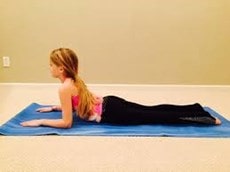
For prone back extensions, lie face down on a mat or other cozy surface.
Contract your lower back muscles to slowly lift your chest off the floor while maintaining your pelvis on the mat.
Lower yourself back down after maintaining the elevated position for a few seconds.

Superman exercise: Place your arms over your head and your legs straight on a mat while lying face down.
To keep your neck in alignment, simultaneously raise your arms, torso, and legs off the ground while maintaining a downward gaze.
Return to the downward position after a brief period of holding the upper position. Perform 3–5 sets of 10–15 repetitions.
bridge pose
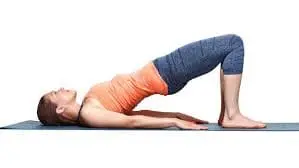
The patient lies on their back with their legs flat and bent on the floor, hip-width apart.
While lying on the plinth, keep your arms by your sides.
Lift the patient’s hips off the plinth and press through your heels to form a straight line from your shoulders to your knees.
Contract your glutes while using your core.
Hold the bridge position for a few seconds before lowering yourself back down. Perform 3–5 sets of 10–15 repetitions.
Cat-Cow Stretch
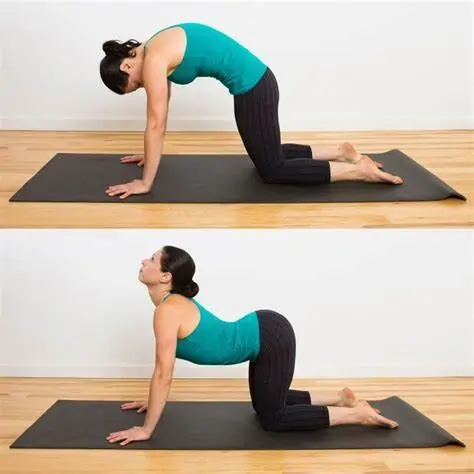
Place your hands and legs together on a tabletop to start.
After taking a deep breath, take the cow pose by arching your back and raising your tailbone.
The “cat pose” involves tucking your chin to your breast, bending your back, and tucking your tailbone.
Pay attention to your breathing as you move between these two postures.
Perform ten to fifteen reps.
Child’s Pose Extension:
To start, kneel with your knees wide apart and your big toes touching.
On your heels, lean back and extend your arms in front of you.
Slowly lower your chest to the floor while keeping your hips on your heels.
Feel the lower back stretch and hold it for a few deep, long breaths.
Always use proper technique and exercise moderation when working these muscles.
It’s advisable to consult a doctor or physical therapist before starting a new exercise program if you currently have back issues or other health concerns. Their counsel can be customized based on your needs and limitations.
FAQs
What are the benefits of lumbar extension?
You will improve your ability to coordinate movement through your lower back by performing the back extension exercise. A stronger and more flexible back is another improvement. All things considered, these benefits result in improved back posture, which is crucial for avoiding back injuries.
What are the exercises for lumbar extension?
Stand with your feet shoulder-width apart.
Put your hands on your small back.
As much as it is comfortable for you, slowly bend your spine back.
Return to the fully upright position after a few seconds of holding the end position.
Repeat for 10 repetitions.
What are signs of a weak lower back?
neck stiffness or reduced range of motion.
muscular knot or tight spot in the back.
loss of coordination or equilibrium.
loss of bladder or bowel control.
weakening of the muscles.
Bilateral numbness or tingling in the limbs, usually on both sides of the body
How to sleep with back pain?
If you have back pain, consider sleeping on your side in the fetal position with a pillow between your knees. In the event that you prefer sleeping on your back, place a pillow beneath your knees to relieve strain. Avoiding stomach sleep and making sure your mattress and pillows provide adequate support might also be beneficial.
References:
- Patel, D. (2023m, August 17). Lumbar flexion and extension – movement, ROM, exercises. Samarpan Physiotherapy Clinic. https://samarpanphysioclinic.com/lumbar-flexion-and-extension/
- Patel, D. (2023e, May 31). Manual Muscle Testing of the trunk (MMT of the trunk muscles). Samarpan Physiotherapy Clinic. https://samarpanphysioclinic.com/manual-muscle-testing-of-the-trunk/#Trunk_extension

